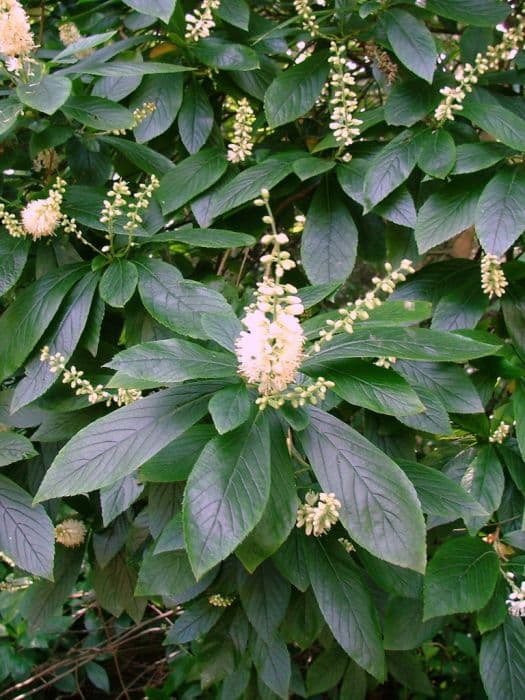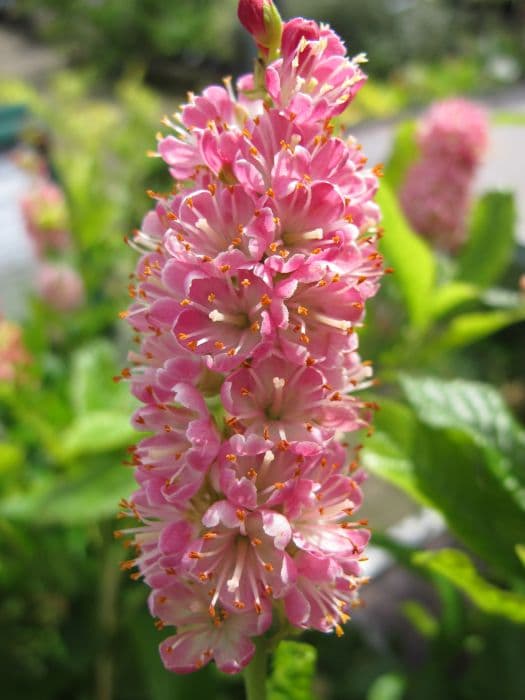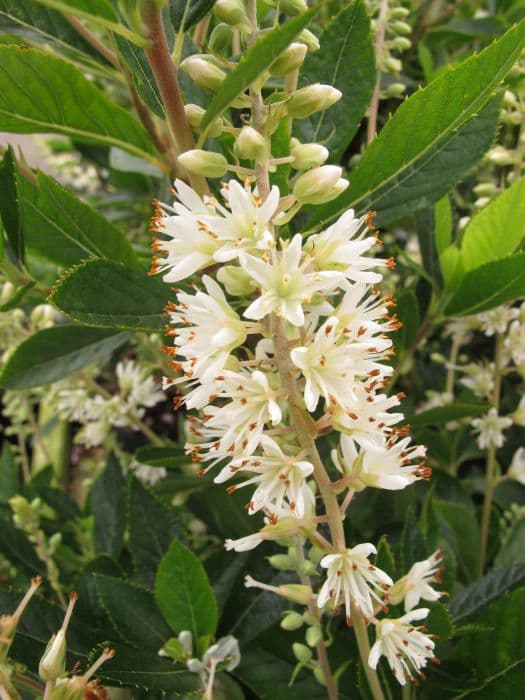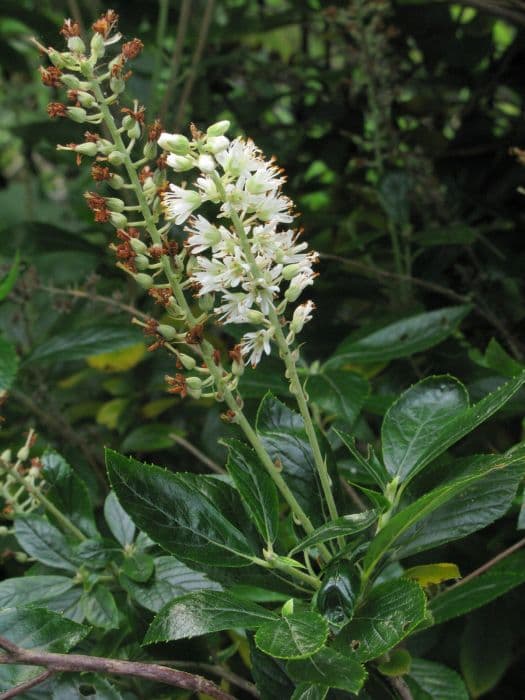Summersweet Clethra alnifolia 'Paniculata'

ABOUT
Clethra alnifolia 'Paniculata', commonly known as Summersweet, is a deciduous shrub that is noted for its attractive foliage and blooms. The plant has glossy, green leaves that are oval-shaped with pointed tips and finely serrated edges, which provide a lush background for its flowers. During the bloom period, typically in mid to late summer, Summersweet produces striking, fragrant flower spikes. These blooms are densely packed with small, white flowers, each with a delicate, slightly fuzzy appearance. The flowers are arranged in elongated clusters known as racemes and emit a sweet scent that attracts a variety of pollinators, including bees and butterflies. The branches of Summersweet are slender and may be upright or slightly arching, contributing to the plant's overall graceful form. Its bark is usually smooth and may acquire a light greyish hue as it matures. After the blooming season, the plant produces small capsules that contain seeds. As autumn approaches, the foliage of Summersweet undergoes a transformation, turning to brilliant shades of yellow, gold, or orange, adding to the autumn landscape's color palette. The combination of its fragrant summer blooms and vibrant fall foliage makes Summersweet an appealing plant for gardeners who seek multi-season interest.
About this plant
 Names
NamesSynonyms
Summersweet, Sweet Pepperbush.
Common names
Clethra alnifolia.
 Toxicity
ToxicityTo humans
The plant commonly known as summersweet is considered non-toxic to humans. Therefore, ingesting parts of summersweet typically does not result in poisoning or adverse health effects.
To pets
Summersweet is also considered to be non-toxic to pets. It is not known to cause any significant symptoms of poisoning or negative health consequences if pets ingest parts of this plant.
 Characteristics
CharacteristicsLife cycle
Perennials
Foliage type
Deciduous
Color of leaves
Green
Flower color
White
Height
3-6 feet (0.91-1.83 meters)
Spread
3-6 feet (0.91-1.83 meters)
Plant type
Shrub
Hardiness zones
3-9
Native area
North America
Benefits
 General Benefits
General Benefits- Attracts Wildlife: Clethra alnifolia 'Paniculata', commonly known as Summersweet, attracts bees, butterflies, and other pollinators due to its fragrant flowers.
- Ornamental Value: With its attractive, densely-packed white flowers, Summersweet adds visual interest to gardens and landscapes.
- Adaptable: Summersweet is tolerant of a variety of soil conditions, including wet and clay soils.
- Shade Tolerant: This plant can thrive in partial shade, making it suitable for woodland gardens and shady areas.
- Fragrance: Summersweet emits a pleasant, sweet fragrance, enhancing the sensory appeal of the environment.
- Seasonal Interest: The plant provides extended interest from summer to fall, with blooms typically lasting from July to August.
- Low Maintenance: Summersweet requires minimal care once established, making it an easy plant for gardeners of all skill levels.
- Naturalizing: It can spread slowly over time, making it good for naturalized areas or to fill in spaces in garden beds.
- Habitat Support: Summersweet provides food and shelter for various species of wildlife, contributing to local biodiversity.
- Non-Invasive: Unlike some ornamentals, Summersweet tends to be non-invasive and stays where planted.
 Medical Properties
Medical PropertiesThis plant is not used for medical purposes.
 Air-purifying Qualities
Air-purifying QualitiesThis plant is not specifically known for air purifying qualities.
 Other Uses
Other Uses- Clethra alnifolia 'Paniculata', commonly known as summersweet, can be used as a natural insect repellent in gardens due to its strong fragrance which is pleasant to humans but disliked by many pests.
- The dense branching pattern of summersweet provides excellent cover and nesting opportunities for small birds and wildlife seeking refuge and habitation.
- Summersweet's abundant nectar-rich flowers are valuable for supporting pollinator populations, particularly bees and butterflies, which depend on such plants for sustenance.
- The plant's dried flowers can be used in potpourri mixes to impart a lasting sweet fragrance to your home environment.
- With its attractive, exfoliating bark, summersweet can be incorporated into winter gardens as a source of visual interest during the dormant season.
- As an educational tool, summersweet can be planted in school gardens to teach children about the importance of native plant species and their role in supporting local ecosystems.
- The wood of summersweet is sometimes used in small-scale woodworking projects or as part of rustic handicrafts, giving a unique, natural look to homemade creations.
- When strategically placed, summersweet can be utilized for erosion control on slopes or river banks, thanks to its spreading root system that holds soil in place.
- Garden designers may use summersweet for sensory gardens, where its fragrance, flower texture, and the sounds of visiting wildlife add to the multisensory experience.
- During fall, the foliage of summersweet provides autumnal color in the landscape when its leaves turn vibrant shades of yellow and gold.
Interesting Facts
 Feng Shui
Feng ShuiSummersweet is not used in Feng Shui practice.
 Zodiac Sign Compitability
Zodiac Sign CompitabilitySummersweet is not used in astrology practice.
 Plant Symbolism
Plant Symbolism- Attractiveness: Clethra alnifolia 'Paniculata', also known as Sweet Pepperbush, is known for its attractive and fragrant white flowers, symbolizing an alluring persona.
- Purification: The Sweet Pepperbush is commonly found in wetlands, which are ecosystems known for purifying water; hence, it can symbolize cleansing and purity.
- Resilience: This plant often grows in challenging wetland conditions, representing the ability to thrive in difficult situations.
- Healing: With its use in traditional medicine, Sweet Pepperbush may also represent healing and restorative properties.
 Water
WaterSummersweet should be watered deeply once a week, providing about 1 gallon of water per square yard of soil, to ensure that the moisture penetrates well into the root zone. During hot or dry spells, it may require more frequent watering to maintain consistently moist soil. Always check the top inch of soil for dryness before watering, as over-saturation can lead to root rot. In the fall and winter, reduce watering as the plant's growth slows and it requires less moisture. Ensure proper drainage to prevent standing water at the base of the Summersweet.
 Light
LightThe ideal light conditions for Summersweet is partial shade to full sun. It thrives best when planted in a location that receives dappled sunlight throughout the day or direct morning sun followed by afternoon shade. Too much direct sunlight can lead to leaf scorch, whereas too little light can reduce flowering.
 Temperature
TemperatureSummersweet is quite adaptable and can withstand a broad range of temperatures; it typically survives winter temperatures as low as -30 degrees Fahrenheit and can handle summer heat up to 100 degrees Fahrenheit. However, the ideal temperature range for promoting healthy growth and blooming is between 60 and 75 degrees Fahrenheit.
 Pruning
PruningPrune Summersweet in late winter or early spring before new growth appears to shape the shrub and remove any dead or damaged branches. Thinning out old stems encourages better air circulation and more vigorous growth. Pruning is not required annually but doing so every few years helps maintain a desirable size and stimulates the growth of fresh fragrant flowers.
 Cleaning
CleaningAs needed
 Soil
SoilSweet Pepperbush thrives best in a soil mix that is rich, well-draining, and high in organic matter. A blend of 2 parts garden soil, 1 part sand, and 1 part compost or peat moss can create an ideal growing environment. Maintaining a soil pH between 5.0 and 6.5 will ensure the plant has access to necessary nutrients and good growth.
 Repotting
RepottingSweet Pepperbush does not need frequent repotting and may be repotted every 3-4 years. Repotting is best done in late winter to early spring before new growth begins, ensuring minimal disturbance to the plant.
 Humidity & Misting
Humidity & MistingSweet Pepperbush prefers moderate to high humidity levels but is quite adaptable to average outdoor humidity. Establishing a location with good air circulation without overly dry conditions is beneficial for the plant's health.
 Suitable locations
Suitable locationsIndoor
Place Sweet Pepperbush in a well-lit area with indirect light and maintain moist soil.
Outdoor
Plant Sweet Pepperbush in partial shade, mulch well, and ensure soil is moist.
Hardiness zone
4-9 USDA
 Life cycle
Life cycleClethra alnifolia 'Paniculata', commonly known as summersweet, begins its life cycle as a seed that germinates in spring, provided with moist, well-drained soil and partial to full sunlight. The seedling stage then follows, where the young plant establishes its roots and initial leaves. In the vegetative stage, the summersweet grows rapidly, producing woody stems and more leaves, preparing for the eventual reproductive phase. During the flowering stage in mid-to-late summer, the plant produces characteristic white to pink fragrant flowers that attract pollinators such as bees and butterflies. After pollination, the flowers develop into fruit (seed capsules), which mature in the fall and release seeds for the next generation. Finally, in the dormant stage, the plant experiences reduced metabolic activity during the colder months but will resume growth with the return of warmer weather in spring.
 Propogation
PropogationPropogation time
Summer to Fall
Propogation: Clethra alnifolia 'Paniculata', commonly known as Summersweet or Sweet pepperbush, is most commonly propagated through softwood cuttings. To do this effectively, gardeners should take cuttings in late spring or early summer when new growth is mature enough yet still flexible. Cut a segment of about 4 to 6 inches (10 to 15 centimeters) from the tip of a healthy branch, making sure that it includes at least two sets of leaves. Remove the leaves from the lower half of the cutting and dip the cut end into rooting hormone. The cutting should then be placed in a well-draining potting mix, ensuring that the leafless part is buried and the remaining leaves are above the soil surface. The pot should be kept in a humid environment with indirect sunlight and the soil should be consistently moist but not waterlogged. Roots typically develop after a few weeks, at which point the new Summersweet plant can be gradually acclimated to its eventual garden location.




